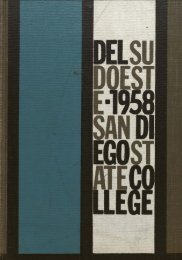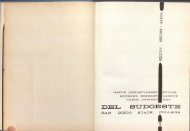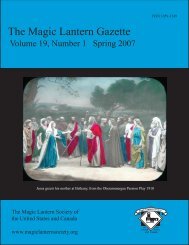The Magic Lantern Gazette - Library
The Magic Lantern Gazette - Library
The Magic Lantern Gazette - Library
Create successful ePaper yourself
Turn your PDF publications into a flip-book with our unique Google optimized e-Paper software.
Early <strong>Magic</strong> <strong>Lantern</strong>s 15<br />
Journal, Vol.9, No 6, Summer 2004), trying to prove their British origin. Barnes<br />
considers them as phantasmagoria lanterns made in the early 19th century. <strong>The</strong><br />
issue is unresolved.<br />
7. An engraving, based (?) on this painting and titled as “L’Optique. Tiré du<br />
cabinet de Monseigneur le duc de Picquigny” (c.1750) has been published by<br />
Robinson, <strong>The</strong> <strong>Lantern</strong> Image, No. 1, p. 20. A copy of the engraving is in the<br />
collection of the Cinema Museum of the French Cinémathèque, Paris.<br />
8. Ludolf von Mackensen, Die Naturwissenschaftlich-Technische Sammlung.<br />
Geschichte, Bedeutung and Ausstellung in der Kasseler Orangerie, Kassel:<br />
Georg Wenderoth Verlag, 1991, p. 26.<br />
9. Centuriae opt., 1668, 222 (see Franz Paul Liesegang, Dates and Sources. A<br />
contribution to the history of the art of projection and to cinematography, Translated<br />
and edited by Hermann Hecht, London: <strong>The</strong> <strong>Magic</strong> <strong>Lantern</strong> Society of<br />
Great Britain, 1986, p. 11.) Hecht notes that Giuseppe’s brother Matteo also<br />
made a projection-clock.<br />
10. See Robinson, <strong>The</strong> <strong>Lantern</strong> Image, No. 12, p. 15. It should be noted that the<br />
lantern in Sturm’s illustration is seen from the backside, not from the front. In<br />
both the illustration and the Kassel Nachtuhr, the embossed clockface (a decorative,<br />
non-functional detail) is on the backside. <strong>The</strong> lantern is in beautiful condition,<br />
although the original clockwork mechanism has been replaced.<br />
11. According to Deac Rossell, the travel diary was published, but he has not<br />
been able to locate a copy. (e-mail message from Rossell to the author, Oct.30,<br />
2007).<br />
12. Liesegang, Dates and Sources, p. 12. Treffler was mentioned by Joh.<br />
Joachim Becher, Närrische Weissheit und weise Narrheit, Frankfurt, 1682, p. 90.<br />
13. See Robinson, <strong>The</strong> <strong>Lantern</strong> Image, No. 11, p. 15.<br />
14. Quoted by Robinson, <strong>The</strong> <strong>Lantern</strong> Image, No. 11, p. 15. As we see, Sturm’s<br />
illustration was published again in later books (see No. 24, p. 17). It still appears<br />
in Johann Georg Kruenitz’s popular Oeconomische Encyclopädie oder Allgemeines<br />
System der Staats-, Stadt-, Haus- und Landwirtschaft, Bruenn, 1786, Bd.<br />
65, Tafel 17 (reproduced in Ich Sehe was du nicht Siehst! Sehmachinen und<br />
Bilderwelten. Die Sammlung Werner Nekes, Herausgegeben von Bodo von<br />
Dewitz und Werner Nekes, Göttingen: Steidl Verlag, 2002, p. 120.) Still, this<br />
does not seem to have led to the production of magic lanterns based on this<br />
design.<br />
15. An image of one of the Kassel lanterns, also sold at the museum as a postcard,<br />
was reproduced (mirrored) in Ernst Hrabalek, Laterna <strong>Magic</strong>a. Zauberwelt<br />
and Faszination des optischen Spielzeugs, Muenchen: Keyser, 1985, p. 47. For<br />
the lantern with the wooden fixture for circular slides, see von Mackensen, Die<br />
Naturwissenschaftlich-Technische Sammlung, p. 128. Wernes Nekes has an<br />
early aquarell depicting a Griendel-Sturm-type lantern in his collection, dated by<br />
him c.1690 and considered to be Dutch. <strong>The</strong> aquarell resembles closely the<br />
illustration in Sturm and may have been simply copied from it. Its function<br />
remains unclear (Ich Sehe was du nicht Siehst!, p. 115).<br />
Nov.1, 2007).<br />
20. Deac Rossell, “<strong>The</strong> True Inventor of the <strong>Magic</strong> <strong>Lantern</strong>,” <strong>The</strong> New<br />
<strong>Magic</strong> <strong>Lantern</strong> Journal, Vol.9, No 1 (Winter 2001), p. 8. Rossell deals<br />
with the complicated relationship between Griendel and Sturm in his<br />
forthcoming history of the magic lantern, part 1 (Fuesslin Verlag, Stuttgart,<br />
2007-08).<br />
21. This rare lantern is identical with the one depicted on the trade card<br />
of the optician Edward Scarlett which has been dated c.1725 (Science<br />
Museum, London, reproduced in Robinson, <strong>The</strong> <strong>Lantern</strong> Image, No. 28,<br />
p. 18). It has an interesting detail that may shed light on Rossell’s research<br />
on the Bull’s-Eye lantern. Rossell points to Benjamin Martin’s<br />
<strong>The</strong> Young Gentleman and Lady’s Philosophy (1763), which contains the<br />
first known illustration of the “Bull’s-Eye lantern”. It differs from the<br />
preserved examples in that it shows “the slide stage cut through the fat<br />
lens tube, instead of being placed at the junction of the body and the lens<br />
tube” (Rossell, “Some Thoughts on the Bull’s-Eye <strong>Lantern</strong>,” p. 74).<br />
This is also the case with the Edinburgh lantern, which has a chimney<br />
closely resembling that of the (later?) Bull’s-Eye lanterns. Martin’s<br />
illustration may thus represent a transitional type. Rossell has informed<br />
me that another incomplete example has been preserved in a private<br />
collection, confirming that this is indeed another “type” (e-mail to the<br />
author, Nov.1, 2007). I am wondering if dating the Aberdeen lantern<br />
with the help of Scarlett’s trade card to the 1720s would be too early?<br />
<strong>The</strong> lantern can be seen at:<br />
http://www.abdn.ac.uk/virtualmuseum/pictures_show2.php? prefix=ABDUA&num=17997&firstview=true&mt=not&sign=&viewnumb<br />
er=&resultsperpage=9<br />
22. <strong>The</strong> lantern can still be seen on the Internet: http://members.nextra.at/<br />
stewar/adv/monat_9907.htm<br />
23. P. Laurenz Doberschiz, Beschreibung der in dem Mathematischen<br />
Thurne zu Cremsmuenster befindlichen Naturalien, Instrumenten, und<br />
Seltenheiten, Herausgegeben von P. Amand Kraml, Specula Cremifanensis<br />
1. Band, Naturwissenschaftliche Sammlungen Krensmuenster, Nr.40<br />
(Februar 1999), Kremsmuenster: Anselm Desing-Verein, pp. 106-109.<br />
24. Doberschiz, Beschreibung, p. 107.<br />
25. For the optical tube, see Robinson, <strong>The</strong> <strong>Lantern</strong> Image, No. 16, p.16,<br />
No. 23, p.17, No. 36, p.19; for the roof, No. 37, p. 19, No. 46, pp. 24-25<br />
and others. A thin tube-like chimney, somewhat resembling that of the<br />
Kremsmuenster lantern, can be found from No 41, p. 20.<br />
26. In his e-mail to the author (October 30, 2007), Rossell mentions that<br />
he has identified “about 26” 18th century lanterns, excluding the Bull’s-<br />
Eye lanterns (about ten according to his latest counting).<br />
16. Compare with No 16, p. 16 in Robinson, <strong>The</strong> <strong>Lantern</strong> Image.<br />
17. Athanasius Kircher, Ars magna lucis et umbrae, the Amsterdam edition<br />
1671. Reproduced in facsimile in Laurent Mannoni, Donata Pesenti Campagnoni<br />
and David Robinson, Light and Movement. Incunabula of the Motion<br />
Picture 1420-1896, Gemona: Le giornate del cinema muto, et al, 1995, p. 67.<br />
18. Rossell, e-mail message to the author, October 30, 2007. <strong>The</strong> information<br />
comes from the curator of the Kassel collection, but it does not seem to be fully<br />
verified by documentation.<br />
19. Deac Rossell, “Die Laterna <strong>Magic</strong>a,” in Ich Sehe was du nicht Siehst! Sehmachinen<br />
und Bilderwelte, 138. According to Rossell, in December 1671<br />
Griendel sent a list of 25 different optical instruments that he was offering for<br />
sale to Johann Gottfried Leibniz. Rossell has discovered Griendel’s catalogue<br />
from 1672 or 1673, now considered the oldest surviving printed catalogue from<br />
a European scientific instrument maker. (Rossell, e-mail message to the author,<br />
Illustrations of two magic lanterns from Stephane Chauvin, Lexicon Philosophicum<br />
Secundis (1713). From David Robinson, <strong>The</strong> <strong>Lantern</strong> Image, p. 17<br />
(see note 14).

















